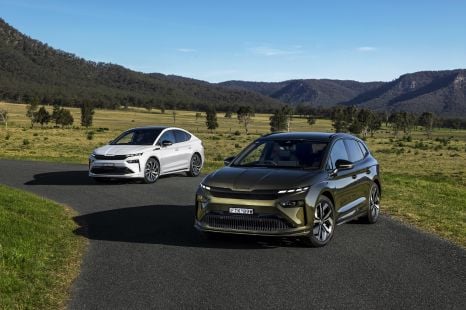

Max Davies
Skoda aiming for Tesla with new electric SUVs
5 Hours Ago
The new Triton is Mitsubishi's most important launch since the Outlander, and the Japanese brand has its sights set on the ute sales podium.
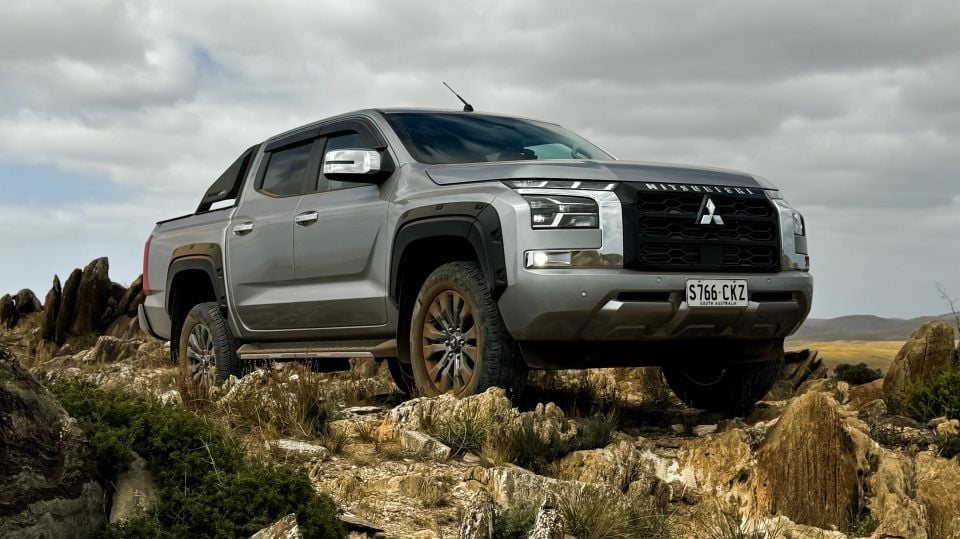


Quickly see how this car stacks up against its competition. Select any benchmark to see more details.
Where expert car reviews meet expert car buying – CarExpert gives you trusted advice, personalised service and real savings on your next new car.
The 2024 Mitsubishi Triton has finally landed in Australia.
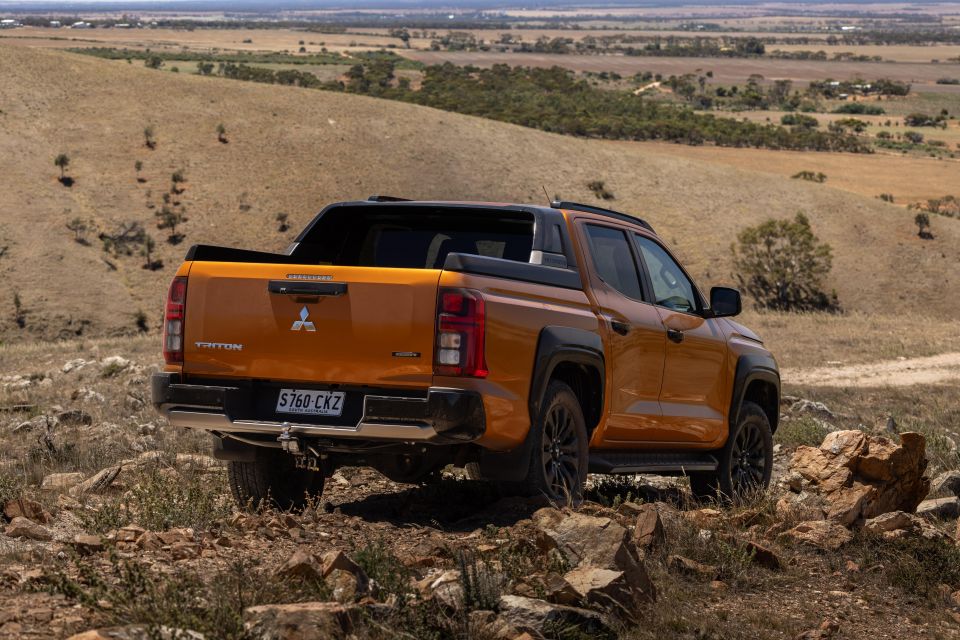
It’s the brand’s second-best seller behind the Outlander SUV, and shapes as a critical product for the company in ute-hungry Australia.
Now in its sixth generation, the Triton – or L200 as it’s known elsewhere – is marketed in nearly 150 countries and has sold a cumulative 5.6 million units worldwide since the original launched in 1978.
Australia ranks as its third largest market behind ASEAN (Association of Southeast Asian Nations) and Latin America. Last year some 16,600 examples of the previous model were registered Down Under; the year before that over 27,400 examples found Aussie homes.
That’s despite the fifth-gen Triton turning 10 years old in 2024, and being up against incredibly strong rivals that probably need no introduction – the Ford Ranger, Toyota HiLux and Isuzu D-Max to name a few.
Mitsubishi has gone hard on capability and technology for this latest iteration, with notable gains in size, practicality, towing capacity, performance, and of course safety – all areas where old one was fast falling behind the pack.
Ride, handling and refinement were also high on the priority list, with a new, more rigid chassis underpinning the dual-cab ute. It packs suspension revisions and a new variable power steering system for a more confident and engaging drive.
Mitsubishi Motors’s chief product specialist, Yoshiki Masuda, said development of this ‘New-Gen Triton’ started in 2017, and the company’s local arm hopes it can help catapult it back into the third spot on the sales charts behind the Ranger and HiLux.
We headed to South Australia to properly trial the new ute on-road and off-road to see if it has a good shot at hitting those goals.
Pricing for the new Triton is up to $7600 dearer than the equivalent predecessor, and at launch just dual-cab versions with automatic transmissions will be offered – though Cab Chassis, Club Cab and manuals are all on the way.
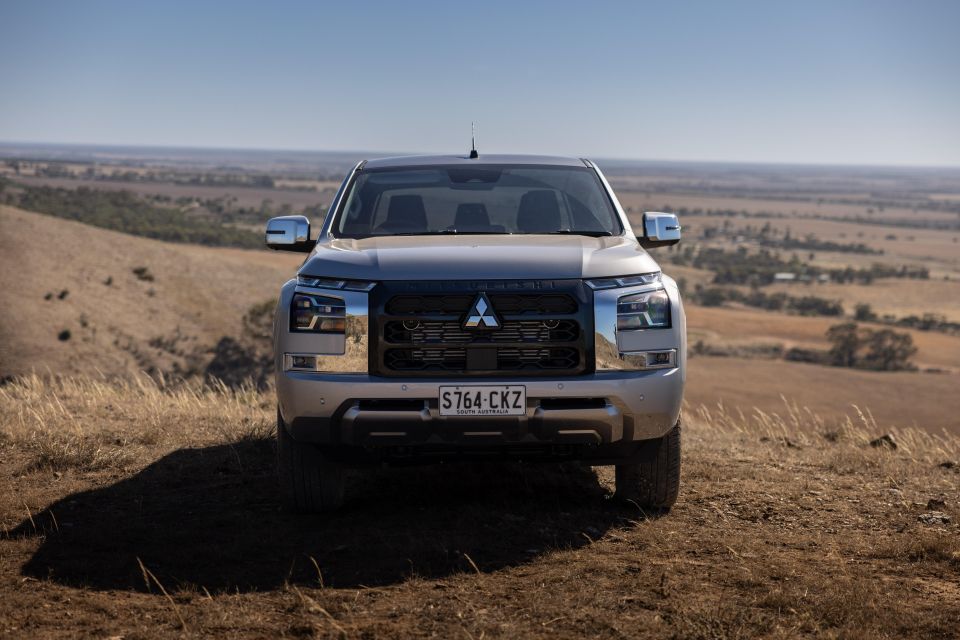
2024 Mitsubishi Triton pricing:
Prices exclude on-road costs
To see how the new Triton stacks up against its rivals, check out our comparison tool.
Buy your new car without the stress. It's fast, simple and completely free.

Great service from Travis and team, second time I have used this business would not hesitate to recommend them to anyone
Craig C.
Purchased a Ford Ranger in Sunshine Coast, QLD
CarExpert helped Craig save $7,224 on his Ford Ranger, now let us save you on your next new car.
Get your BEST priceIf the new exterior look was a big change, wait until you hop inside.
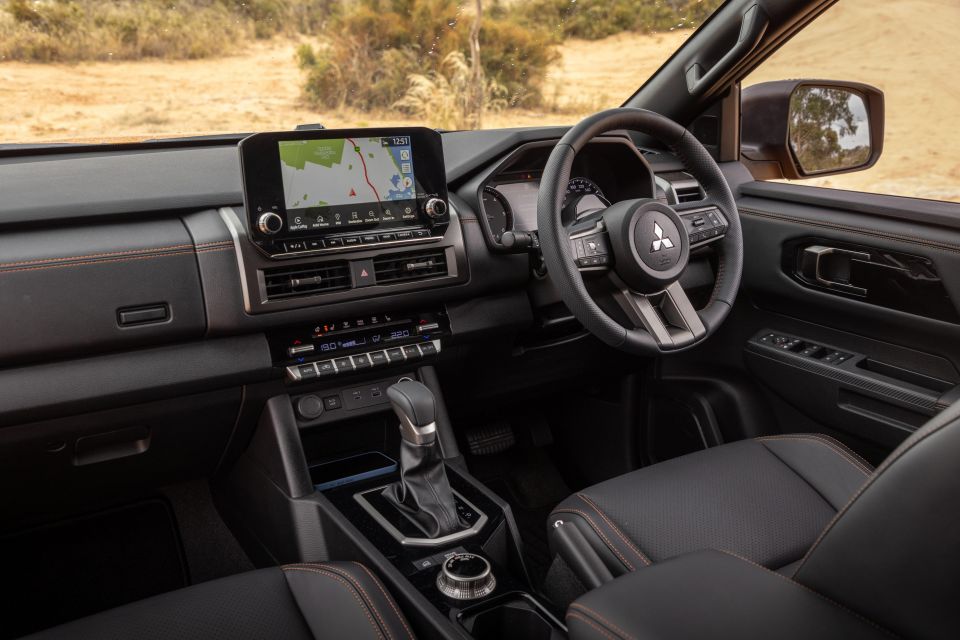
The old Triton was feeling old inside particularly in terms of tech and design. Here, Mitsubishi has taken an almost two-generation leap.
It’s a very bluff and upright design, with plenty of straight lines and chunky buttons to reiterate the tough and rugged pitch. But look closer and it gets some handy new displays that won’t scare off a Ranger or Amarok, but definitely take the Triton from being one of the worst to one of the best in segment.
A tactile new steering wheel looks like it could have come out of a Lancer Evolution, with a sporty circular hub and a thin rim that feels just right. There’s no fully digital instrument cluster, but the new 7.0-inch TFT display flanked by clean and classic analogue dials works just fine here.
The standard 9.0-inch central touchscreen is a freestanding design and is effectively lifted out of various Renault-Nissan-Mitsubishi Alliance vehicles like the Outlander and Nissan X-Trail SUVs.
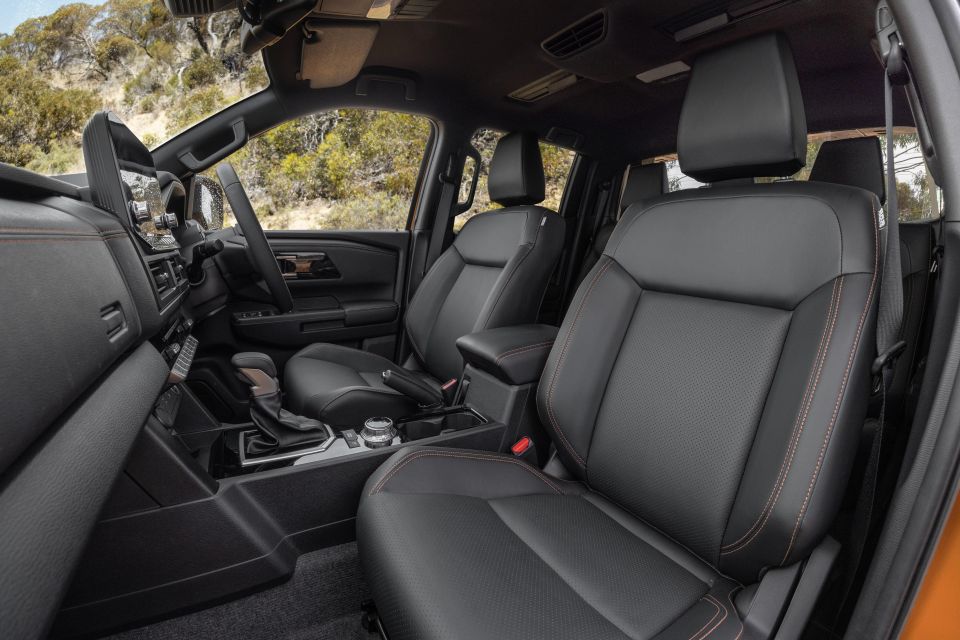
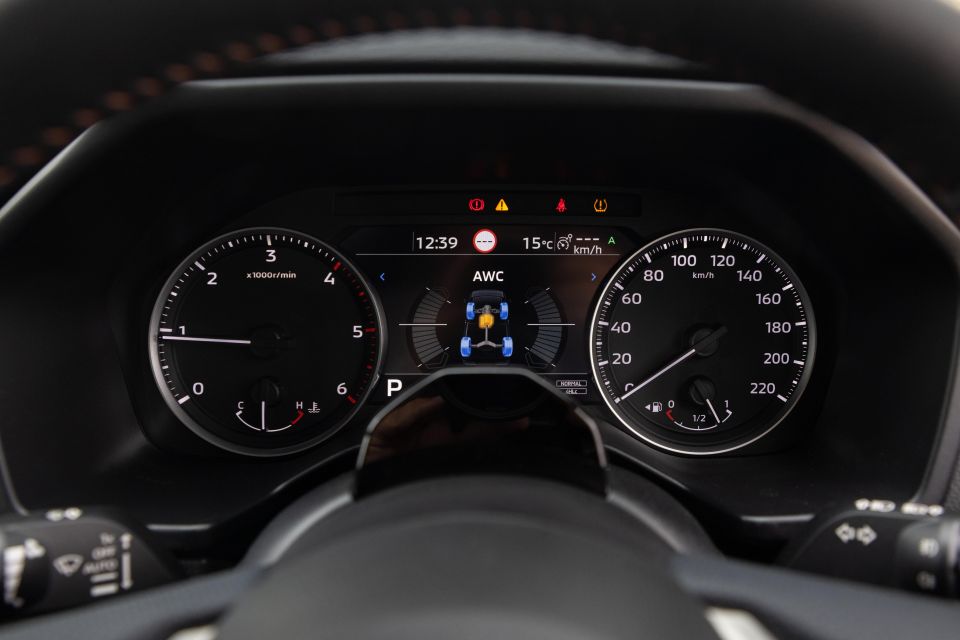


It comes with satellite navigation, as well as wireless Apple CarPlay and wired Android Auto from the base GLX grade, though you need to step up to the GLX+ for DAB radio.
As in the other Alliance models this unit features in, it’s user friendly, well featured, and the 9.0-inch display is good for the segment. The glossy black finish could be prone to scratches and fingerprints, however.
The toggle-style switches for the climate controls look good and are tactile to use, and there are storage options including a rubberised phone holder that doubles as a wireless charger on the GLS and GSR.
We only trialled the GLS with Leather Interior Option ($1500) and GSR both with leather upholstery and powered driver seats. In these specs the captain’s pew is comfy and supportive for long journeys, though sportier side bolstering would have been welcome for harder cornering or when venturing onto the rough stuff.
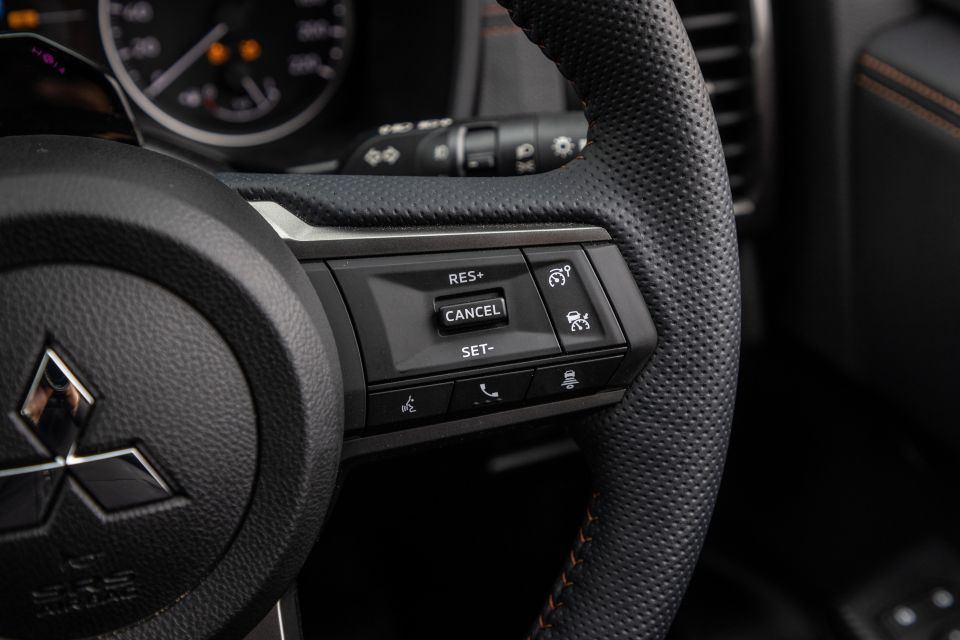
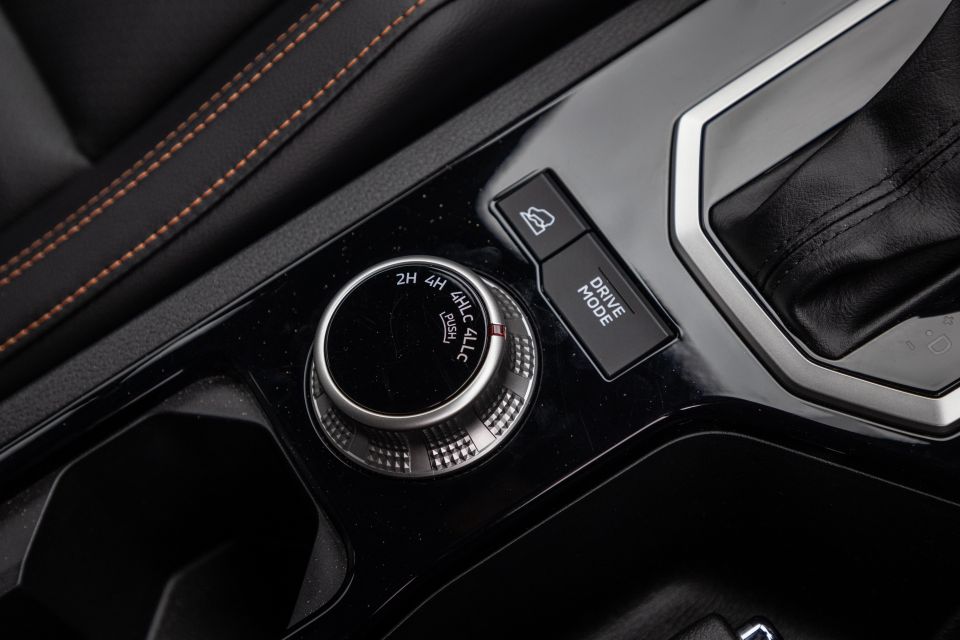
Mitsubishi says it has raised the hip point of the driver’s seat by 20mm for a more upright posture, and the available power lumbar support offers better comfort and support on the lower back.
Door handles and the 4WD selector have been designed to be the ‘perfect fit’ for fingers, even when using gloves. The 4WD selector’s push and rotate operation is claimed to stop fingers from hitting other panels.
Likewise the steering wheel rim has been carefully design to offer secure grip for fingers, as well as a thumb rest for when ‘gripping softly’.
Other practical solutions include dash-mounted cupholders in the flagship GSR – why not across the range? – as well as door pockets large enough for big bottles and an A4 clip board.
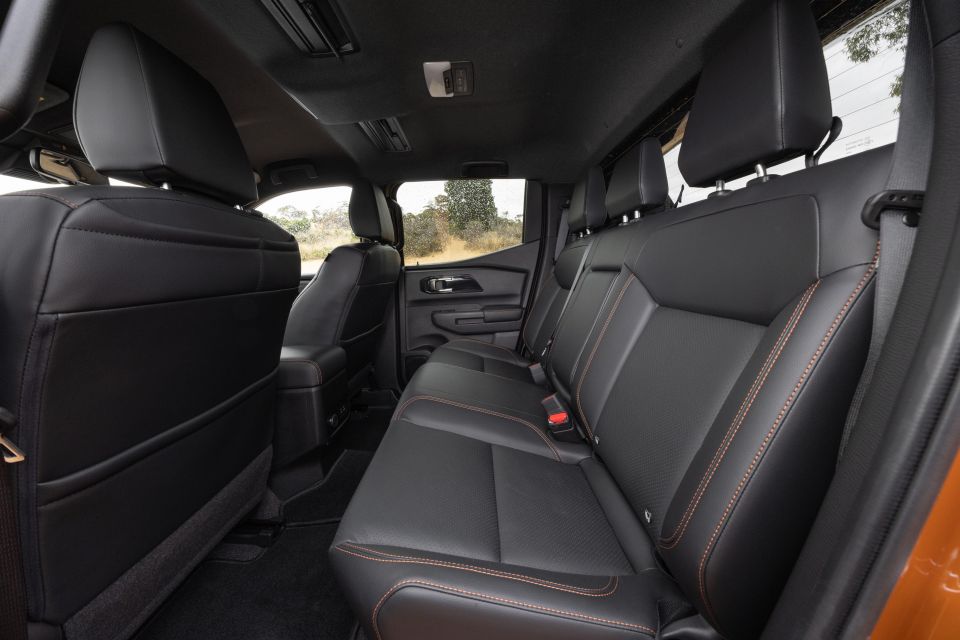
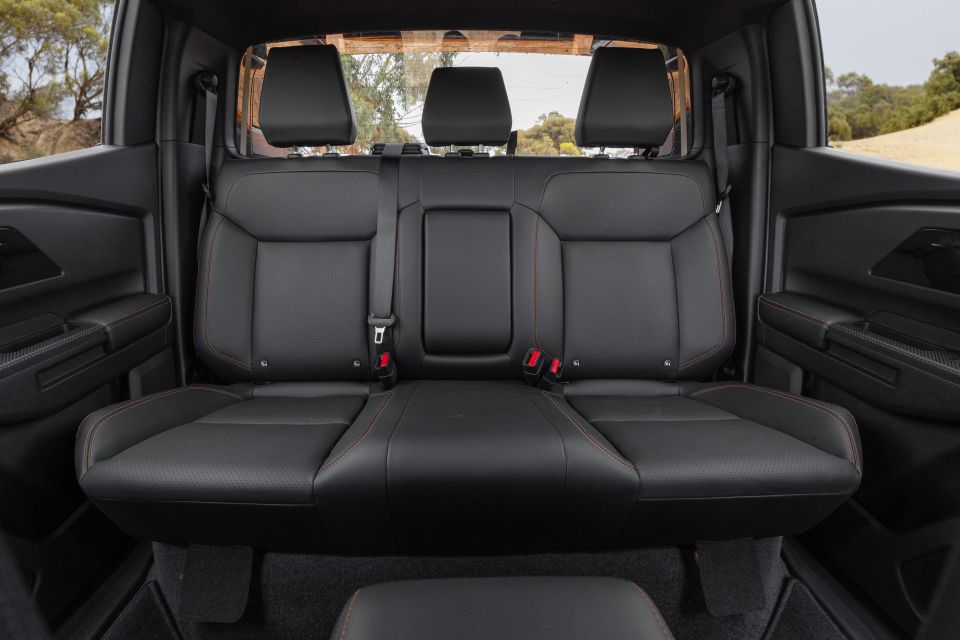
Behind the front passenger’s seat are personal device pockets that can hold a laptop and phone while they’re connected to charge ports.
The swollen vehicle dimensions have opened up more space in the rear. Where the old Triton was compact by ute standards, the new one is a more practical option with very good seating for four, five at a pinch if you need.
A fold-down centre armrest with cupholders is handy when only the outer seats are in use, and Mitsubishi has retained the roof-mounted rear air circulator which claims significantly improved A/C performance compared to the old model.
Parents planning to use their Triton for work and play can secure little ones using the supplied ISOFIX anchors and top-tether points where required.
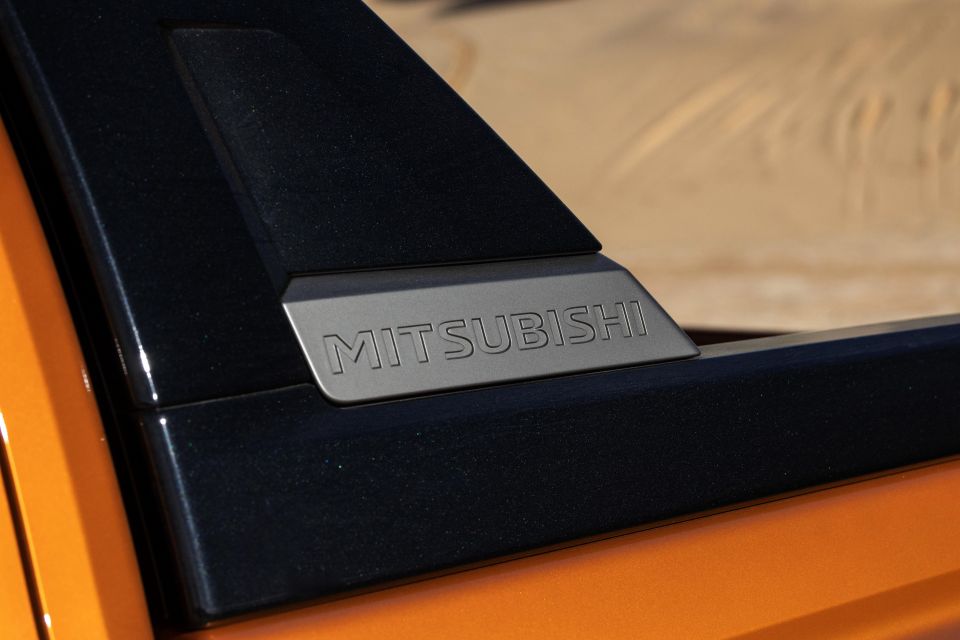
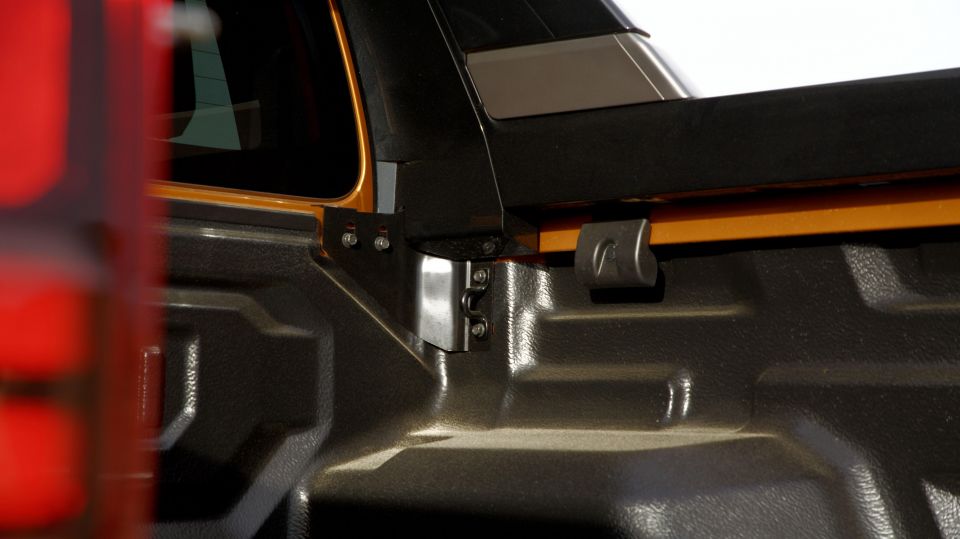
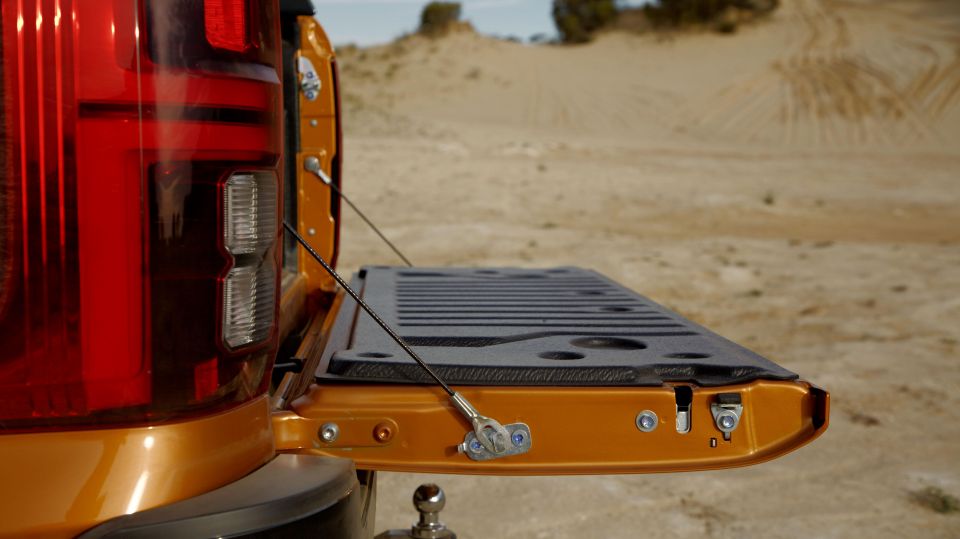

The tub has been revised to offer a 42mm lower load floor height for easier access, which now sits at 821mm off the ground for models fitted with 18-inch wheels. When fitted with a bedliner, the Triton has capacity for a standard Euro pallet.
The tray for Dual Cab versions has grown 35mm in length to 1555mm, with width quoted at 1545mm. It’s 526mm deep, and there’s 1135mm between the arches. A full-size spare wheel lives under the tray.
The Triton has been treated to a new Euro 6-certified bi-turbo diesel.
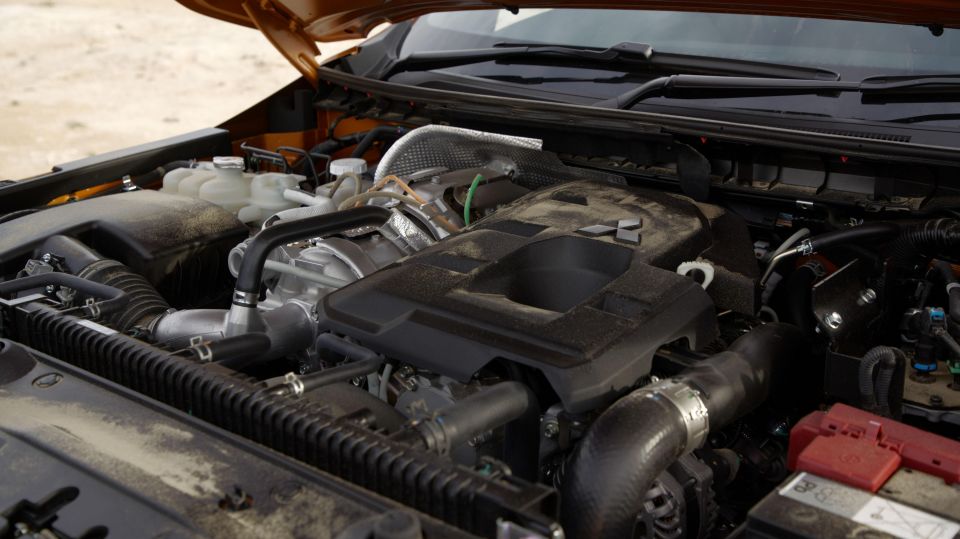
| Model | Mitsubishi Triton 2.4 4N16 |
|---|---|
| Engine | 2.4L 4cyl bi-turbo diesel |
| Power | 150kW (3500rpm) |
| Torque | 470Nm (1500-2750rpm) |
| Transmission | 6-speed automatic |
| Driven wheels | Rear-wheel drive or four-wheel drive |
| Weight | 2000-2170kg (kerb) |
| Fuel economy (claim) | 7.5-7.7L/100km |
| Fuel tank size | 80 litres |
| Gross vehicle mass | 3070kg (2WD) to 3200kg (4WD) |
| Gross combination mass | 6210kg (2WD) to 6250kg (4WD) |
| Payload | 1030kg (GSR) to 1110kg (GLX+ Club Cab) |
| Braked towing | 3500kg |
The old Triton always drove well enough, but the new one has to prove itself against segment leaders.
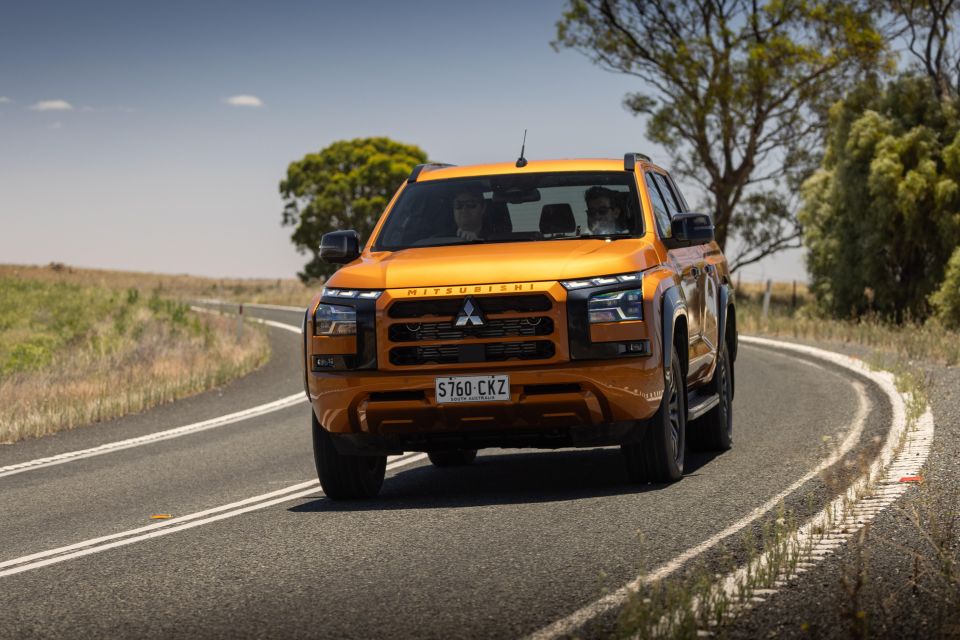
Our first stint behind the wheel was leaving the Adelaide Airport and out into the hills, over a mix of city, suburban, highway and country driving.
From the get-go, the Triton’s new Euro 6-certified bi-turbo diesel showed excellent refinement for the class, with minimal noise intrusion and clatter relative to what is a fairly agricultural segment, and pretty smooth pulling power in everyday scenarios.
The six-speed automatic – while down on cogs compared to some rivals – shifts smoothly and decisively. Media quizzed Mitsubishi as to why the Triton didn’t move to the eight-speeder found in the Pajero Sport, though Masuda-san said the existing six-speed was found to be the best fit for the Triton’s application, with revised ratios.
It’s best driven in a measured manner, as you can reach its limits revving it out hard. The otherwise refined drivetrain can get a little vocal when pushed – and let’s face it, this isn’t a Ranger Raptor so you shouldn’t need to drive it like a performance car anyway.
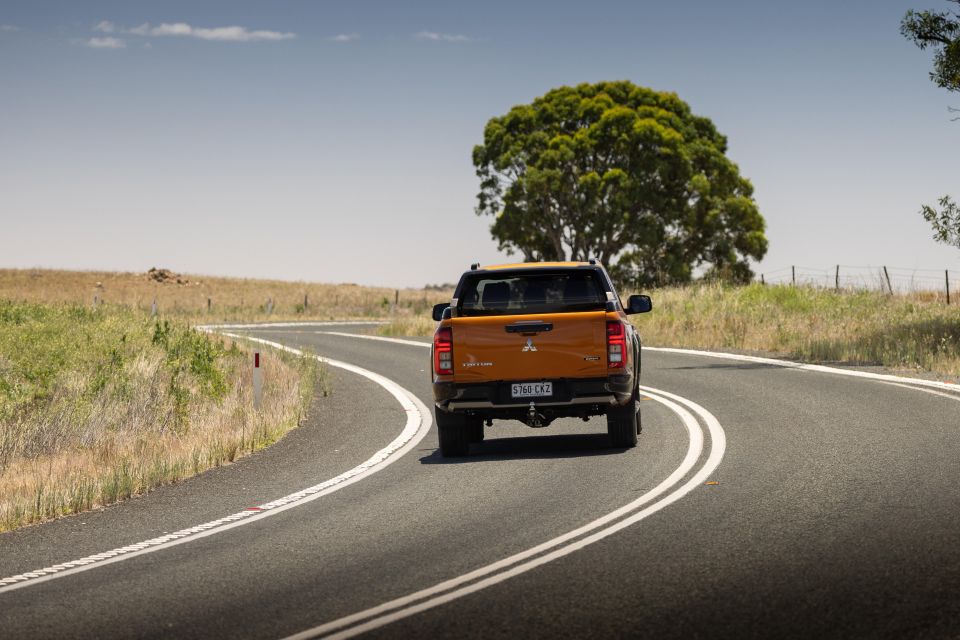
Perhaps my highlight of the Triton’s drive experience is the steering, which is among the best systems I’ve experienced in a dual-cab ute of late.
The new variable-ratio electronically-assisted rack balances manoeuvrability and feel very nicely, and makes the Triton feel like a much smaller car than it really is. It also does a great job of avoiding the vagueness around centre you get in some other utes and 4WDs with super light electric steering.
It offers accurate responses, and weighs up as the speed climbs or lock increases. It inspires more confidence both in corners and the open road, but also helps to avoid that twirly-whirly feel when doing carpark manoeuvres.
There’s also a new Active Yaw Control function which uses torque vectoring via braking for more confident cornering. While it didn’t explicitly make its presence felt, that’s kind of the point.
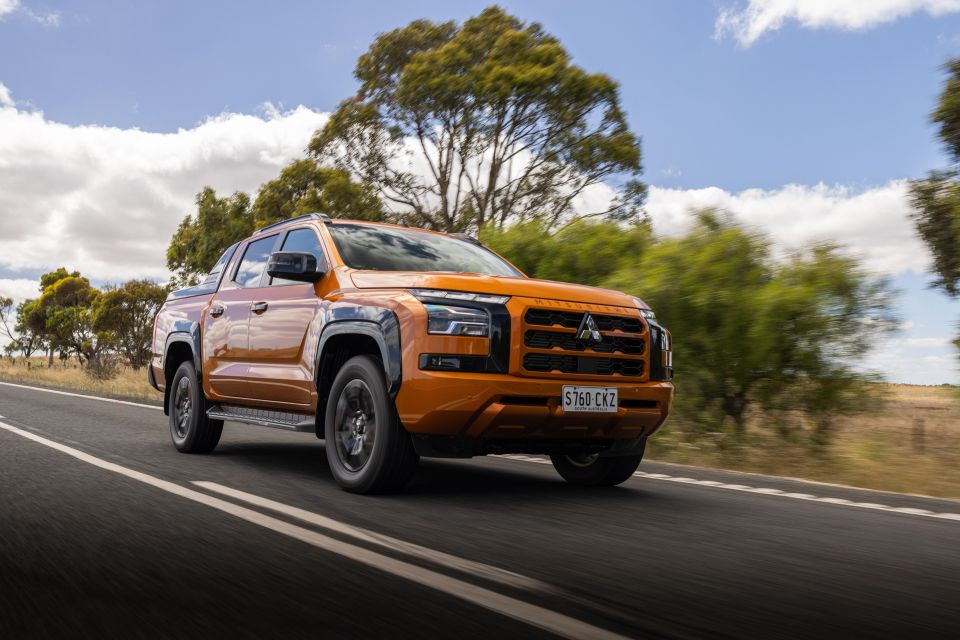
Road noise is kept at bay pretty well, though those big mirrors bring about a bit of wind whistle and buffeting once you start driving at over 100km/h – particularly in the windier conditions we encountered.
Masuda-san quoted a 60 per cent increase in bending rigidity and 40 per cent in torsional rigidity thanks to the new chassis frame. While there is definitely less flex and shimmying than the last Triton, we noted a pretty unsettled ride over pockmarked city streets as well as over corrugated surfaces at lower speeds.
This is where the Triton simply cannot match the likes of the Ford Ranger and Volkswagen Amarok, which are as close to SUVs as you can get for a tray-backed vehicle in this price bracket. Many Triton owners are likely to have the vehicle loaded up with weight in the tray regularly, which should offset this somewhat.
Unfortunately we were not able to test it with a payload beyond people and luggage, nor did we perform any kind of tow test. It will be interesting to see how the new bi-turbo oiler fares with more weight tacked on, given the Triton now quotes 3.5 tonnes of braked towing capacity.
During our Dual Cab Ute Mega Test in 2023, CarExpert found the entire field of four-cylinder utes were unable to reach 100km/h on the high-speed bowl at our Proving Ground towing a 1600kg trailer dynamometer set to 3 kilonewtons (kN), which is designed to simulate a fairly steep ascent – we’ll have to put it to the test with a longer loan.
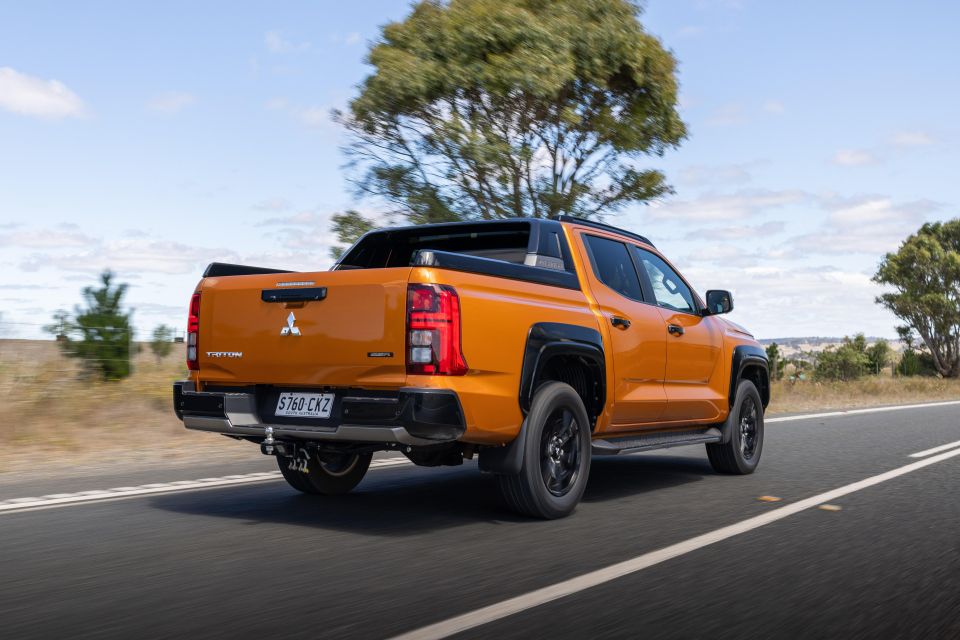
The Triton otherwise was pretty well-sorted in other on-road scenarios, save for a couple of mid-corner skips when going over a bump during a turn at speed. You could feel the rear lose composure for a moment, which again may be remedied with weight in the back.
Another major development for Triton has been the assistance tech, which is now in line with the segment benchmarks. You get stuff like adaptive cruise control and lane keep assist which is helpful on the open road, while front and rear cross-traffic alerts as well as blind-spot warning help when negotiating higher traffic scenarios.
We didn’t have much trouble with the driver attention monitoring, which uses a steering-mounted camera to track the driver’s eyes and face to detect fatigue or distraction. Save for one instance while off-roading where it completely freaked out, it wasn’t as intrusive as some other systems on the market.
I will note the Triton lacks a semi-autonomous highway assistant or lane centring function like some rivals (i.e. Ranger, D-Max and BT-50) which can take the load off, but for many this is a good-to-have rather than a necessity. Thankfully the steering is accurate enough that you rarely find yourself wallowing about in your lane or having to make many corrections on the move.
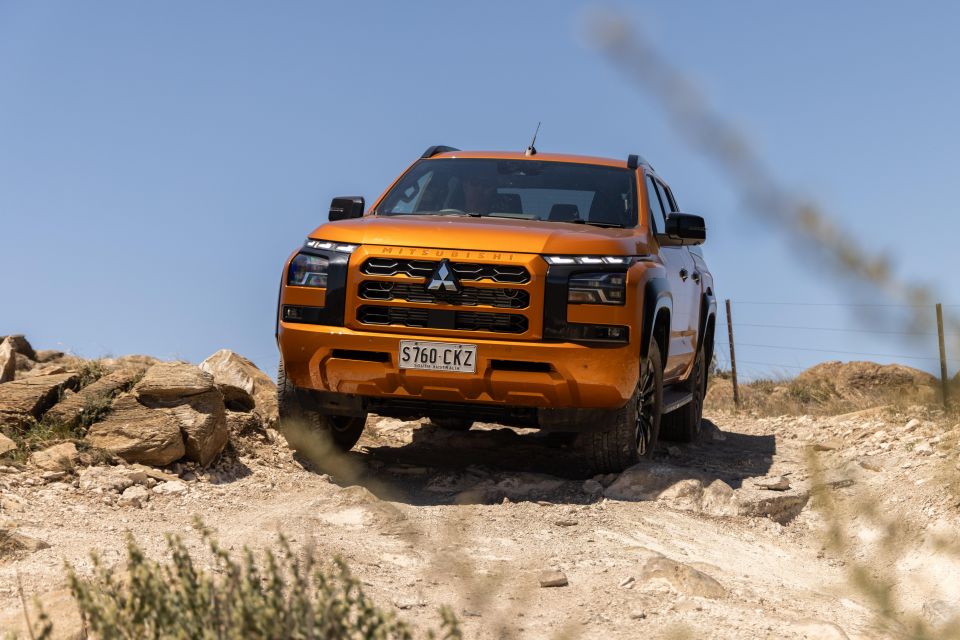
Where expert car reviews meet expert car buying – CarExpert gives you trusted advice, personalised service and real savings on your next new car.
Now, the rougher stuff at Eagle View 4WD Track in Sanderston, about a 90-minute drive east of the South Australian capital.
Here we took the Triton through a number of trails, which ranged from mild to more challenging dips and climbs featuring dirt, sand and some pretty rocky sections as well. We also tested out the high-spec Triton’s Super Select II 4WD system with various modes, and just general grip, clearance and articulation.
Approach, ramp-over and departure angles differ depending on grade – GLX and GLS quote 30.4/23.6/22.8 degrees respectively, while the GSR is 29.0/23.6/22.8 degrees. Minimum ground clearance is 222mm across the range for Dual Cab Pickup versions.
We drove the GLS and GSR off the beaten track, giving us access to the Triton’s full suite of 4WD features.
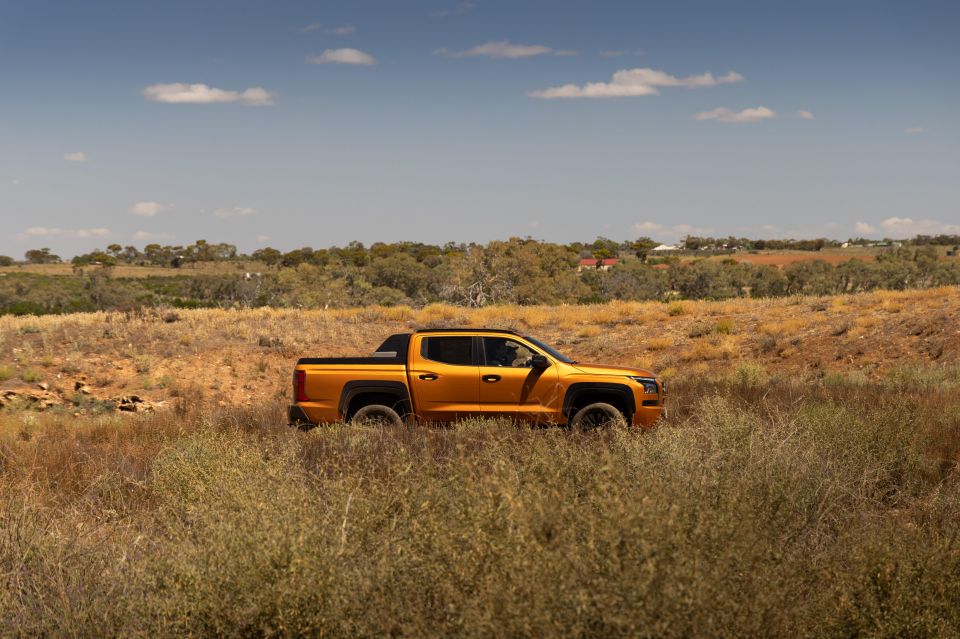
Most of the initial exercises were doable in the 4H drivetrain mode, which unlike most competitors is usable on sealed surfaces as well as unsealed surfaces.
Even with jagged rock edges, sharp dips and steep climbs, the new Triton walked up like a mountain goat on its standard tyres – which on the GLS and GSR were Maxxis Bravo AT-790 265/60 units.
Using the 4HLc (with locked centre differential) makes these tasks easier but for most of the time we didn’t even need it, or to engage low range.
For a lot of people the Triton will offer more 4WD capability than you’ll ever need, and serves as a great starting point for those who frequent the aftermarket.
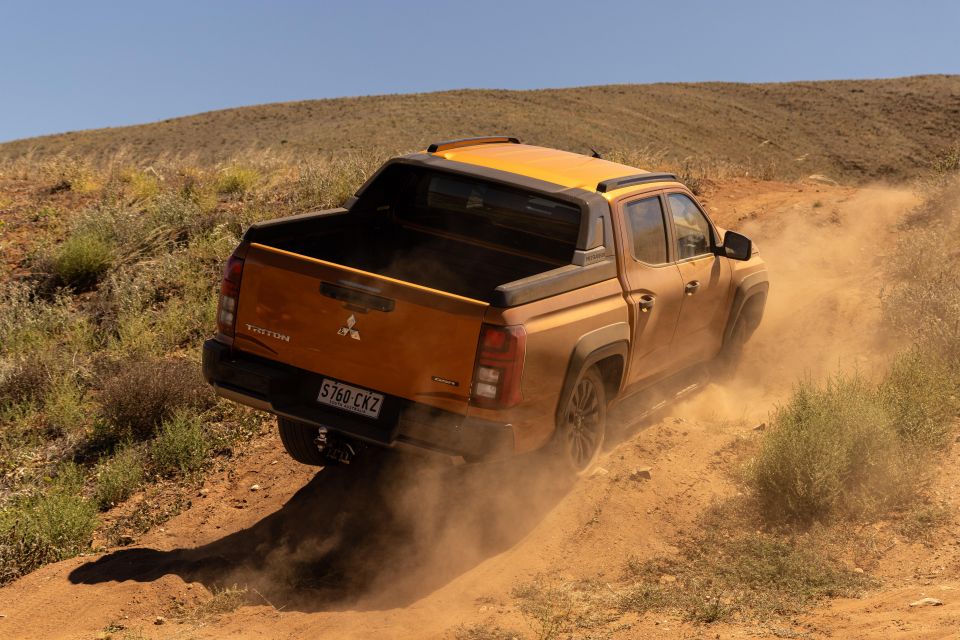
The surround camera system standard from the GLX+ grade came in handy when navigating tighter sections or driving over crests, as the Triton’s wide and bluff bonnet could limit forward visibility in these scenarios.
You can also toggle through various terrain modes which team with the 4WD modes to tailor the drivetrain response and electric assists to optimise the Triton for the terrain – choose from Normal, Eco, Gravel, Snow, Mud, Sand and Rock.
It would have been good to try the GLX or GLX+ with the standard 4WD system, or the base model without the limited-slip rear differential. But, from what I saw of said vehicles in the convoy, they had barely any more trouble than I did navigating the trails than I did in the Super Select II-equipped GLX and GSR.
All told, this won’t be knocking the Ford Ranger off its mantle anytime soon, but it’s definitely competitive with the likes of the HiLux, D-Max and BT-50 which are all still more expensive like-for-like.
While there have been price increases, there’s much more standard equipment.

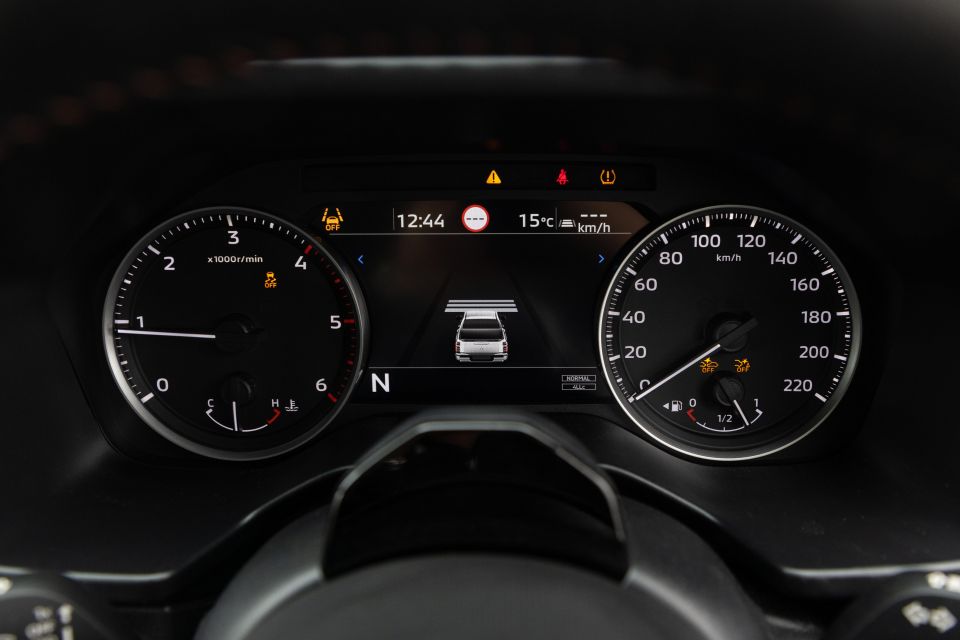

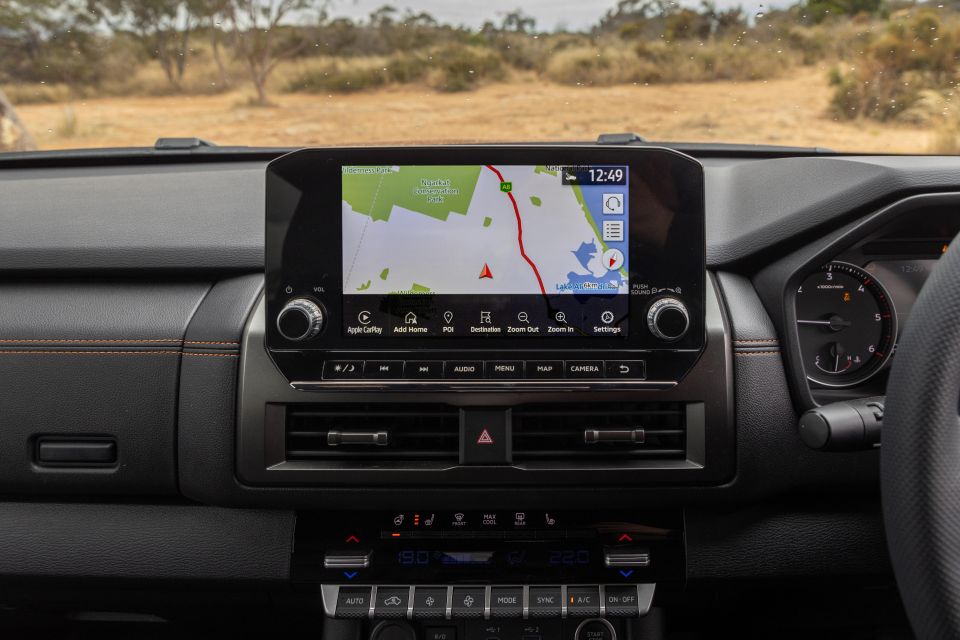
Triton GLX highlights:
Triton GLX+ adds:
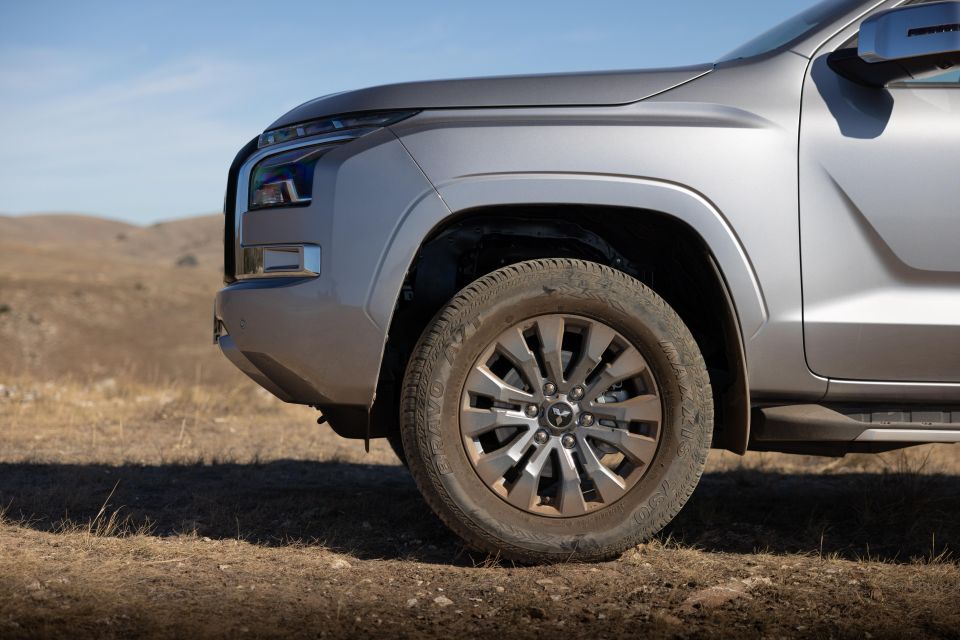

Triton GLS adds:
Triton GSR adds:
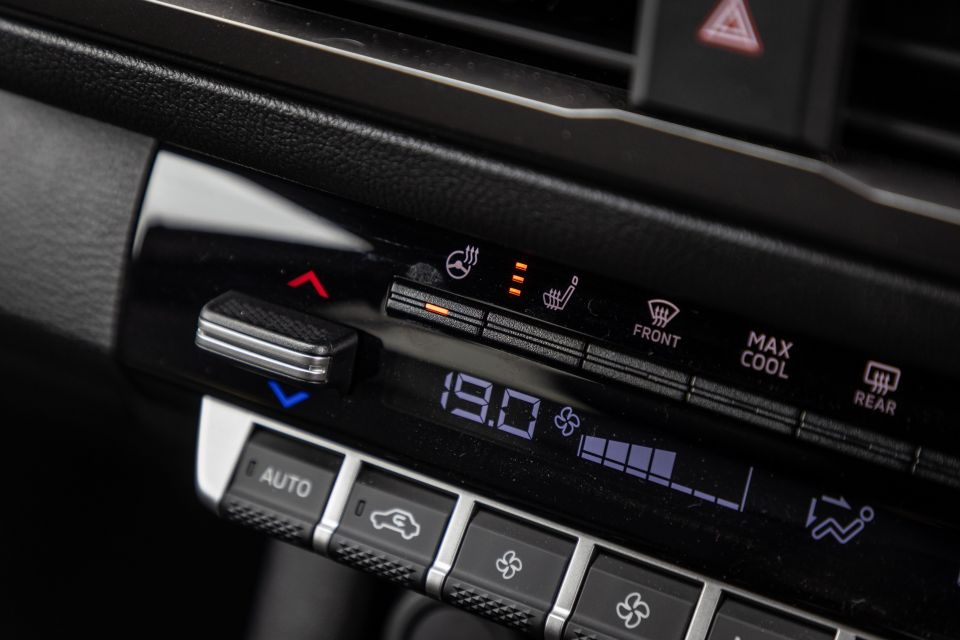
GLS Leather Interior Option: $1500
Available colours depend on variant.
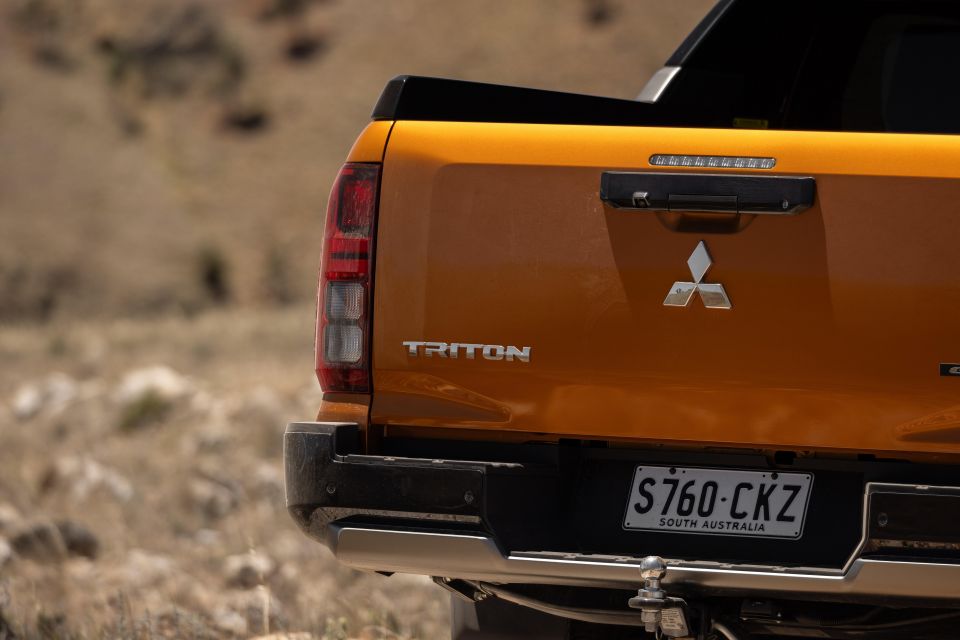
The Mitsubishi Triton has yet to be tested by ANCAP.
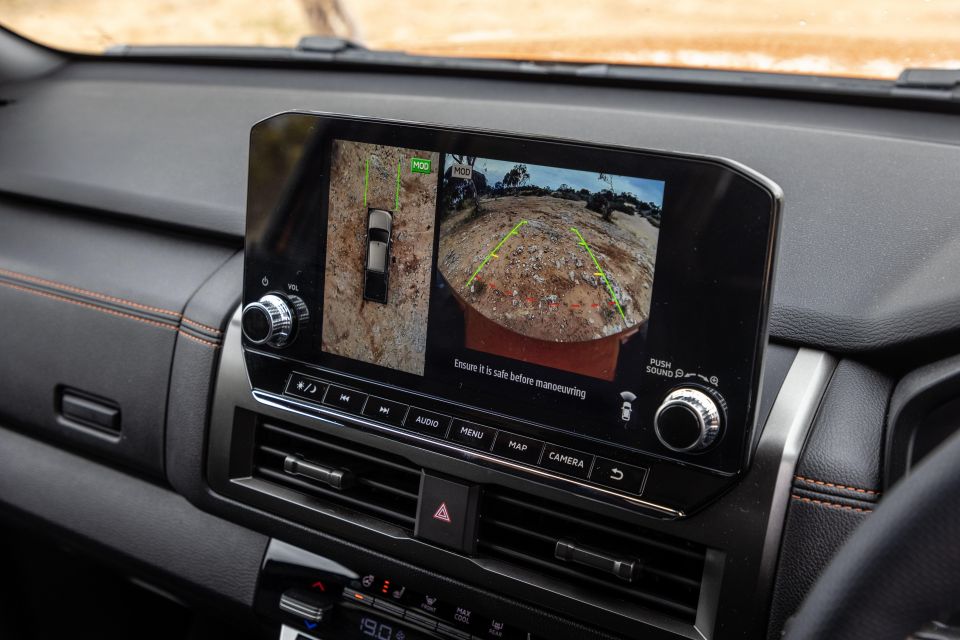
Standard safety equipment includes:
GLX+ and up get a surround-view camera and rear AEB.
The 2024 Mitsubishi Triton is backed by a 10-year, 200,000km warranty if you service through Mitsubishi dealers.
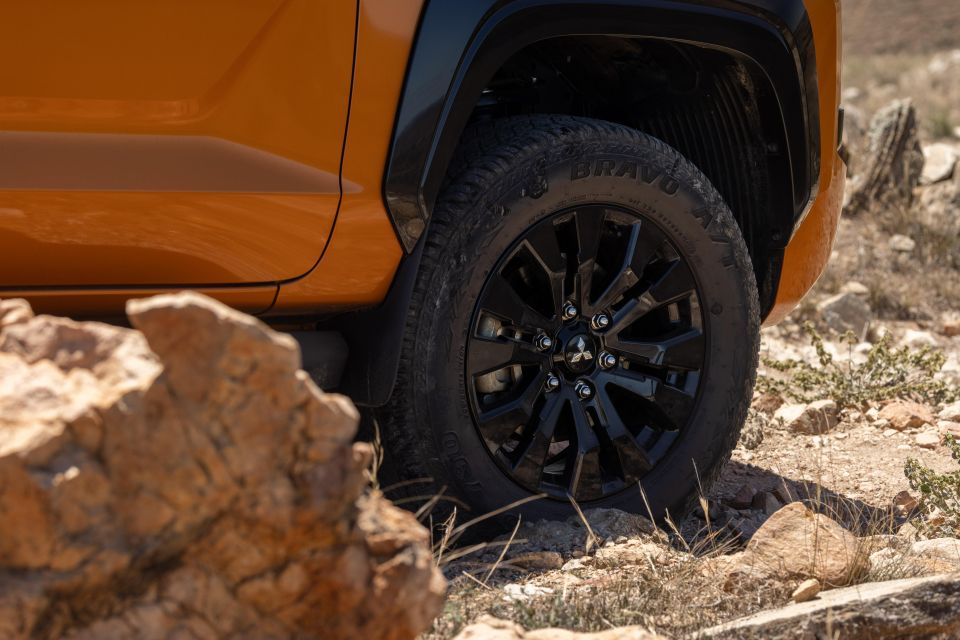
Mitsubishi offers a 10-year capped-price servicing program too, with the same 12-month/15,000km intervals as before.
The company says it has worked to reduce ongoing running costs, including parts that require less servicing than before, which has led to a $50 reduction in total maintenance costs over the 10-year term.
2024 Mitsubishi Triton service pricing:
| Interval | 1yr/15k | 2yr/30k | 3yr/45k | 4yr/60k | 5yr/75k | 6yr/90k | 7yr/105k | 8yr/120k | 9yr/135k | 10yr/150k | Total |
|---|---|---|---|---|---|---|---|---|---|---|---|
| Cost | $489 | $489 | $489 | $489 | $489 | $799 | $749 | $949 | $849 | $899 | $6690 |
While our launch drive wasn’t necessarily indicative of real-world conditions, we struggled to get near the brand’s high-7.0L/100km claim, seeing closer to 9-10L/100km on higher-speed country roads.
The Triton’s EU6 diesel also brings about AdBlue injection, which means there’s and additional tank for the substance – a non-hazardous, non-toxic, and non-inflammable aqueous urea fluid that converts noxious nitrogen oxides (NOx) into nitrogen, water, and tiny amounts of carbon-dioxide in the exhaust chamber.
Shaun Westcott, CEO for Mitsubishi Motors Australia, said in response to doubts about vehicles running out of AdBlue and going into limp-home mode: “Fingers crossed, depending on how much you drive you will typically not need to top up or refill your AdBlue between services.”
Read more about what Mitsubishi Australia is doing to educate dealers and customers about AdBlue here.
Buy your new car without the stress. It's fast, simple and completely free.

Great service from Travis and team, second time I have used this business would not hesitate to recommend them to anyone
Craig C.
Purchased a Ford Ranger in Sunshine Coast, QLD
CarExpert helped Craig save $7,224 on his Ford Ranger, now let us save you on your next new car.
Get your BEST priceThis is a massive step forward for the Triton nameplate.
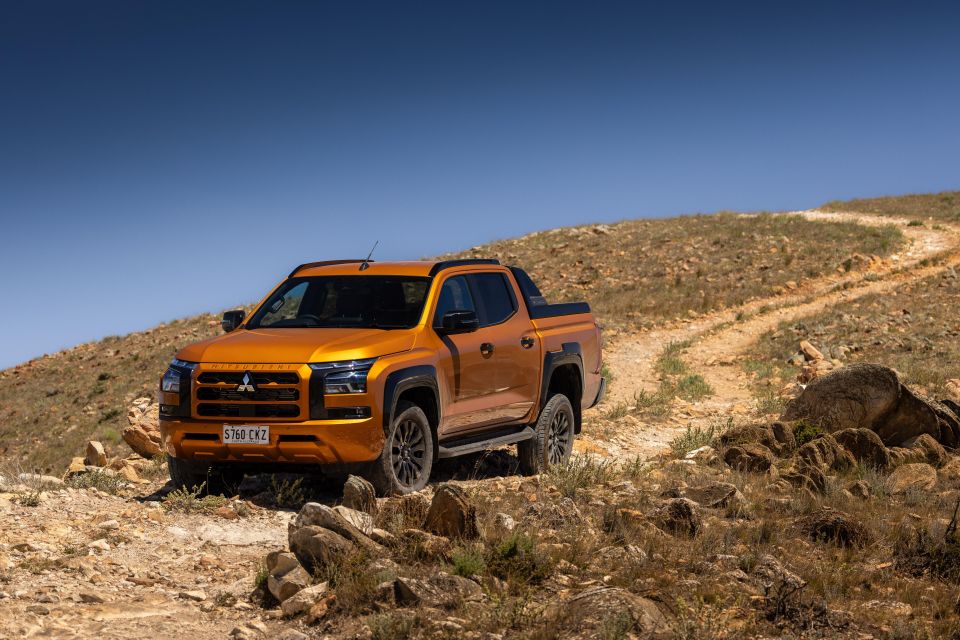
The technology, drivetrain, refinement and capability developments are almost a two-generation jump instead of just one, and put the Triton back in contention with some of Australia’s most popular new vehicles.
However, while it’s been a marked change over the ancient predecessor, it still cannot match class leaders like the Ranger and Amarok for their on-road manners and tech suites – but they do cost quite a bit more.
What it lacks in V6 muscle and all-road prowess, the Triton makes up for in value, aftersales support and blends new-age tech and features with the wonderful simplicity that Mitsubishi tends to offer across its range. I also am also very fond of the steering, it’s just so nice.
And, despite price rises across the line-up, the Triton remains solid value relative to its competitors in the segment. You can have a GSR for similar money to a lower-spec Ranger XLT, or a mid-spec D-Max.

There are some sticking points, though. The jittery urban ride will grow tiresome if you rarely fill up the tray with heavier stuff, and the way it skipped over mid-corner bumpers in our experience may be unsettling on a winding high-speed country road that no doubt many a Triton have travelled.
We also have to knock Mitsubishi for not coming to market with a product that moves the game forward in electrification. The Japanese brand is a leader in plug-in hybrid tech, and the Outlander Plug-in Hybrid EV is proof that Mitsubishi can develop a capable PHEV that can carry heavier vehicles with payload requirements.
That said, there is an all-electric pick-up on the way, and the brand’s executives alluded to refinements and improvements in the coming two or three years, with powertrain lineup expansion one of the areas hinted at for further development – basically, watch this space.
For the time being, the sixth iteration of Triton is a worthwhile update that brings Mitsubishi back into the fold with the added surety of one of the longest aftersales programs in the business. It’s definitely worth taking a look if you’re considering any four-cylinder competitor.

Click the images for the full gallery
MORE: Buy a Mitsubishi Triton MORE: Everything Mitsubishi Triton
Where expert car reviews meet expert car buying – CarExpert gives you trusted advice, personalised service and real savings on your next new car.
James Wong is an automotive journalist and former PR consultant, recognised among Australia’s most prolific motoring writers.


Max Davies
5 Hours Ago


Max Davies
5 Hours Ago


Ben Zachariah
7 Hours Ago


William Stopford
7 Hours Ago


James Wong
10 Hours Ago
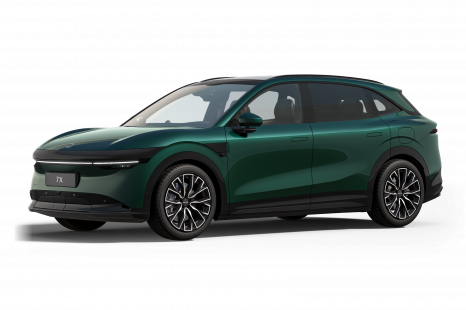

Damion Smy
13 Hours Ago